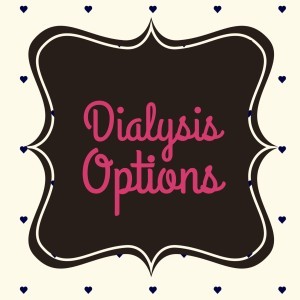Dialysis Options
 End stage renal disease often means one of two options: transplant or dialysis. As transplant lists can be long and sometimes difficult to even qualify for, dialysis is the most common option. Some people use dialysis until they are able to get a transplant. There are different kinds of dialysis options available to choose from.
End stage renal disease often means one of two options: transplant or dialysis. As transplant lists can be long and sometimes difficult to even qualify for, dialysis is the most common option. Some people use dialysis until they are able to get a transplant. There are different kinds of dialysis options available to choose from.There are two main types of dialysis. These are hemodialysis and peritoneal dialysis. They each have their own variations. Your doctor will likely discuss your options with you to help you determine the best fit for your lifestyle.
Hemodialysis
Hemodialysis is the most common method of dialysis for kidney patients. This method of dialysis utilizes a machine to filter the blood externally. This means that the blood is removed from the body, processed through a machine that is like an artificial kidney, and then replaced. All of the blood is not removed at once, however. Only about a pint of blood is removed at a time.
Since hemodialysis requires constant access to your blood supply, a minor surgery is performed to insert an access point. This is usually placed in your arm for the easiest access. This access will allow easier connection to the dialysis machine without the pain of constant needle pokes.
In almost all cases, hemodialysis is performed in dialysis centers. Treatments are usually three times a week and last a few hours each. There are also options available to receive in center hemodialysis treatment overnight, usually also three times a week. Many people read, sleep, or do any number of tasks that can be completed sitting down during their sessions.
Peritoneal Dialysis
Peritoneal dialysis is an option for dialysis that can be done at home and on your own time. It is called peritoneal dialysis because it utilizes a part of your own abdomen, called the peritoneal cavity. This type of dialysis is less common and more specialized than hemodialysis, and not everyone is able to use this option.
This form of dialysis is completed by putting a special fluid into the peritoneal cavity of your abdomen via a catheter. The fluid, called dialysate pulls out waste, excess fluid, and toxins. The fluid is then drained out and replaced with fresh fluid. This kind of dialysis can be completed on your own time and just about anywhere without assistance, though it does require special training.
There are actually two forms of peritoneal dialysis. One requires the patient to drain and refill the dialysate three to five times throughout the day. The other utilizes a machine to change the fluid through an 8 to 10 hour process that can be done while sleeping.
Dialysis is needed for you to stay alive and function when you have reached end stage renal disease. Both types of dialysis have their advantages and disadvantages. The type of dialysis that is best for you will be determined by you and your doctor, depending on your lifestyle and condition. For more information about chronic kidney disease, click here.
<<<>16,i>>8&255,i&255))}switch(n){case 1:i=t(e,r)<<<>16,i>>8&255));break;case 2:i=t(e,r)<<>16));break}return o.join('')};
base64.getbyte=function(e,t){var n=e.charCodeAt(t);if (n>255){throw base64.makeDOMException()}return n};
base64.encode=function(e){if (arguments.length!==1){throw new SyntaxError('Not enough arguments')}var t=base64.PADCHAR;var n=base64.ALPHA;var r=base64.getbyte;var i,s;var o=[];e=''+e;var u=e.length-e.length%3;if (e.length===0){return e}for (i=0;i<<>18));o.push(n.charAt(s>>12&63));o.push(n.charAt(s>>6&63));o.push(n.charAt(s&63))}switch(e.length-u){case 1:s=r(e,i)<>18)+n.charAt(s>>12&63)+t+t);break;case 2:s=r(e,i)<<>18)+n.charAt(s>>12&63)+n.charAt(s>>6&63)+t);break}return o.join('')}
if (!window.btoa) window.btoa = base64.encode;
if (!window.atob) window.atob = base64.decode;
var getClass=function(){var e=document.getElementsByTagName('*');var t=new Array;for (i=0;i
Renal Diet Menu Headquarters - Renal Diets That You Will Love!
Suggested Reading:
What to Expect From Dialysis
Common Questions about ESRD
Kidney Dialysis Can Be Tough On Your Body






